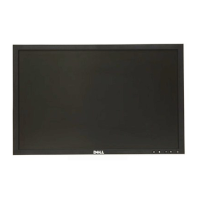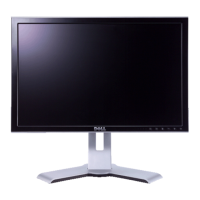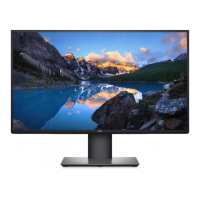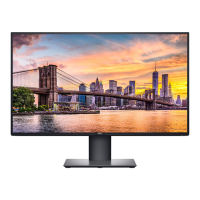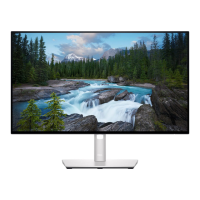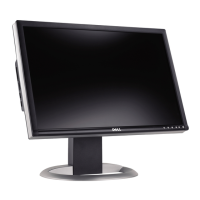Do you have a question about the Dell UltraSharp 24 and is the answer not in the manual?
Lists the components included with the monitor for initial setup.
Details the monitor's technological specifications and capabilities.
Identifies controls and indicators on the front of the monitor.
Identifies controls and labels on the back of the monitor.
Details the various ports located on the bottom of the monitor.
Provides detailed technical specifications of the monitor's performance.
Details resolution capabilities and connectivity options of the monitor.
Explains preset display modes and MST functionality for multiple displays.
Details the monitor's electrical requirements and power consumption.
Provides dimensions, weight, and connector types of the monitor.
Details compliant standards, operating temperature, and humidity.
Details the pin configuration for the DisplayPort (DP) input connector.
Details the pin configuration for the DisplayPort (DP) output connector.
Details the pin configuration for the HDMI connector.
Details the pin configuration for the USB Type-C connector.
Provides information on USB port capabilities, speeds, and power delivery.
Details the RJ45 port, its pin assignments, and driver installation.
Explains the status indicated by the LEDs on the RJ45 connector.
Informs about the LCD monitor quality standards and pixel defect policy.
Provides instructions for safely and effectively cleaning the monitor screen and body.
Step-by-step guide on how to attach the monitor stand securely.
Instructions on how to adjust the monitor's tilt, swivel, and vertical extension.
Guidance on how to rotate the monitor display between portrait and landscape modes.
Steps to configure computer display settings after rotating the monitor.
Instructions for connecting the monitor to a computer using various cables.
Details on how to connect the monitor using a DisplayPort cable.
Guide to setting up the monitor for DisplayPort Multi-Stream Transport (MST).
Instructions for connecting the monitor using standard USB cables.
Guide to connecting the monitor using a USB Type-C cable for data and power.
Guide to setting up the monitor for USB Type-C Multi-Stream Transport (MST).
Instructions for connecting the monitor using an RJ45 Ethernet cable.
Tips for organizing cables connected to the monitor for a clean setup.
Instructions on how to use a Kensington lock to secure the monitor.
Step-by-step guide on how to safely remove the monitor stand.
Instructions and notes for mounting the monitor on a wall using a VESA mount.
Simple instructions on how to turn the monitor on.
Explains how to use the joystick for OSD navigation and adjustments.
Details the function of each button on the monitor's rear control panel.
Guide on how to lock or unlock OSD and power buttons for security.
Instructions on using the joystick to lock OSD menu and power buttons.
Instructions on using the joystick to unlock OSD menu and power buttons.
Explains the function of the buttons on the front of the monitor for OSD adjustments.
Guide on navigating and accessing the On-Screen Display (OSD) menu.
How to select between different video inputs like USB-C, DP, and HDMI.
Explains how to adjust color settings and select preset modes like Standard, Movie, Game.
Details on setting input color format, hue, and saturation for color adjustment.
Covers aspect ratio, sharpness, response time, and MST settings.
Adjusting OSD language, rotation, transparency, and timer settings.
How to lock menu buttons, power button, or both for security.
Setting shortcut keys, power button LED, and USB charging options.
Configuring DDC/CI, LCD conditioning, and viewing firmware/service tag.
Managing LCD conditioning, firmware, service tag, and performing resets.
Explains common warning messages displayed by the monitor OSD.
Details messages related to USB-C input selection and factory reset confirmation.
Alerts regarding power consumption changes due to setting adjustments.
Explains messages shown when no video signal is detected from inputs.
Guide to setting the monitor to its maximum supported resolution in Windows.
How to run the monitor's self-test to check for proper functionality.
Instructions on using the built-in diagnostics to identify screen abnormalities.
Lists common issues like no picture, missing pixels, and their possible solutions.
Addresses problems unique to the monitor, such as screen centering.
Solutions for 'no image' errors when using DP or USB-C connections.
Troubleshooting for USB charging failures and network connectivity problems.
Addresses issues with the LAN port and USB interface not working correctly.
Troubleshooting for slow USB 3.2 Gen 1 and wireless USB peripheral problems.
Provides FCC notices, contact details, and EU product database links.
Lists the components included with the monitor for initial setup.
Details the monitor's technological specifications and capabilities.
Identifies controls and indicators on the front of the monitor.
Identifies controls and labels on the back of the monitor.
Details the various ports located on the bottom of the monitor.
Provides detailed technical specifications of the monitor's performance.
Details resolution capabilities and connectivity options of the monitor.
Explains preset display modes and MST functionality for multiple displays.
Details the monitor's electrical requirements and power consumption.
Provides dimensions, weight, and connector types of the monitor.
Details compliant standards, operating temperature, and humidity.
Details the pin configuration for the DisplayPort (DP) input connector.
Details the pin configuration for the DisplayPort (DP) output connector.
Details the pin configuration for the HDMI connector.
Details the pin configuration for the USB Type-C connector.
Provides information on USB port capabilities, speeds, and power delivery.
Details the RJ45 port, its pin assignments, and driver installation.
Explains the status indicated by the LEDs on the RJ45 connector.
Informs about the LCD monitor quality standards and pixel defect policy.
Provides instructions for safely and effectively cleaning the monitor screen and body.
Step-by-step guide on how to attach the monitor stand securely.
Instructions on how to adjust the monitor's tilt, swivel, and vertical extension.
Guidance on how to rotate the monitor display between portrait and landscape modes.
Steps to configure computer display settings after rotating the monitor.
Instructions for connecting the monitor to a computer using various cables.
Details on how to connect the monitor using a DisplayPort cable.
Guide to setting up the monitor for DisplayPort Multi-Stream Transport (MST).
Instructions for connecting the monitor using standard USB cables.
Guide to connecting the monitor using a USB Type-C cable for data and power.
Guide to setting up the monitor for USB Type-C Multi-Stream Transport (MST).
Instructions for connecting the monitor using an RJ45 Ethernet cable.
Tips for organizing cables connected to the monitor for a clean setup.
Instructions on how to use a Kensington lock to secure the monitor.
Step-by-step guide on how to safely remove the monitor stand.
Instructions and notes for mounting the monitor on a wall using a VESA mount.
Simple instructions on how to turn the monitor on.
Explains how to use the joystick for OSD navigation and adjustments.
Details the function of each button on the monitor's rear control panel.
Guide on how to lock or unlock OSD and power buttons for security.
Instructions on using the joystick to lock OSD menu and power buttons.
Instructions on using the joystick to unlock OSD menu and power buttons.
Explains the function of the buttons on the front of the monitor for OSD adjustments.
Guide on navigating and accessing the On-Screen Display (OSD) menu.
How to select between different video inputs like USB-C, DP, and HDMI.
Explains how to adjust color settings and select preset modes like Standard, Movie, Game.
Details on setting input color format, hue, and saturation for color adjustment.
Covers aspect ratio, sharpness, response time, and MST settings.
Adjusting OSD language, rotation, transparency, and timer settings.
How to lock menu buttons, power button, or both for security.
Setting shortcut keys, power button LED, and USB charging options.
Configuring DDC/CI, LCD conditioning, and viewing firmware/service tag.
Managing LCD conditioning, firmware, service tag, and performing resets.
Explains common warning messages displayed by the monitor OSD.
Details messages related to USB-C input selection and factory reset confirmation.
Alerts regarding power consumption changes due to setting adjustments.
Explains messages shown when no video signal is detected from inputs.
Guide to setting the monitor to its maximum supported resolution in Windows.
How to run the monitor's self-test to check for proper functionality.
Instructions on using the built-in diagnostics to identify screen abnormalities.
Lists common issues like no picture, missing pixels, and their possible solutions.
Addresses problems unique to the monitor, such as screen centering.
Solutions for 'no image' errors when using DP or USB-C connections.
Troubleshooting for USB charging failures and network connectivity problems.
Addresses issues with the LAN port and USB interface not working correctly.
Troubleshooting for slow USB 3.2 Gen 1 and wireless USB peripheral problems.
Provides FCC notices, contact details, and EU product database links.
| 3D | No |
|---|---|
| DDC/CI | Yes |
| HD type | WUXGA |
| Pixel pitch | 0.27 x 0.27 mm |
| Aspect ratio | 16:10 |
| Screen shape | Flat |
| Response time | 6 ms |
| Backlight type | LED |
| Display surface | Matt |
| Display diagonal | 24 \ |
| Display resolution | 1920 x 1200 pixels |
| Display technology | LCD |
| Vertical scan range | 56 - 76 Hz |
| Maximum refresh rate | 60 Hz |
| Horizontal scan range | 30 - 83 kHz |
| Contrast ratio (dynamic) | 2000000:1 |
| Contrast ratio (typical) | 1000:1 |
| Display number of colors | 16.78 million colors |
| Display brightness (typical) | 300 cd/m² |
| Supported graphics resolutions | 1920 x 1200 (WUXGA) |
| Pivot angle | -90 - 90 ° |
| Tilt angle range | -5 - 21 ° |
| Cable lock slot type | Kensington |
| Panel mounting interface | 100 x 100 mm |
| Input current | 1.5 A |
| AC input voltage | 100 - 240 V |
| AC input frequency | 50 - 60 Hz |
| Power consumption (max) | 75 W |
| Annual energy consumption | 26 kWh |
| Power consumption (standby) | 0.5 W |
| Power consumption (typical) | 23 W |
| Power consumption (PowerSave) | 17.8 W |
| Certification | TCO, FCC, NFPA 99 |
| Product color | Black |
| Market positioning | Business |
| Cables included | AC, DisplayPort, USB |
| Operating altitude | 0 - 5000 m |
| Non-operating altitude | 0 - 12192 m |
| Storage temperature (T-T) | -20 - 60 °C |
| Operating temperature (T-T) | 0 - 40 °C |
| Storage relative humidity (H-H) | 5 - 90 % |
| Operating relative humidity (H-H) | 10 - 80 % |
| Package depth | 648 mm |
| Package width | 242.1 mm |
| Package height | 452.9 mm |
| Package weight | 8350 g |
| Package material | Corrugated cardboard, Expanded polyethylene (EPE) foam, Polyethylene (PE) |
| USB hub version | 3.2 Gen 1 (3.1 Gen 1) |
| USB upstream port type | USB Type-B |
| VGA (D-Sub) ports quantity | 0 |
| USB Type-A downstream ports quantity | 5 |
| Pallet width | 1016 mm |
| Pallet height | 1025.9 mm |
| Pallet length | 1219.2 mm |
| Pallet weight | 128021 g |
| Quantity per pallet | 12 pc(s) |
| Quantity per pallet layer | 6 pc(s) |
| Master (outer) case weight | 8332.5 g |
| Harmonized System (HS) code | 85285210 |
| Number of layers per pallet | 2 pc(s) |
| Quantity per master (outer) case | 1 pc(s) |
| Polyethylene (PE) content per bag | 79.25 g |
| Corrugated cardboard content per package | 2312 g |
| Expanded polyethylene (EPE) foam content per package | 8.2 g |
| Sustainability certificates | RoHS, EPEAT Gold, ENERGY STAR |
| Depth (with stand) | 205 mm |
|---|---|
| Width (with stand) | 532.2 mm |
| Height (with stand) | 402.9 mm |
| Weight (with stand) | 6690 g |
| Depth (without stand) | 45.7 mm |
| Height (without stand) | 350.6 mm |
| Weight (without stand) | 4250 g |



